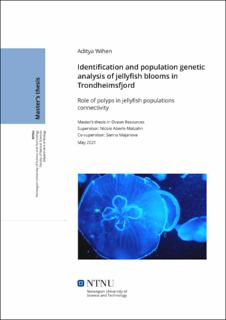| dc.description.abstract | There is a strong need to utilize jellyfish biomass in both economic and ecological way. These two aspects rely on the capability of jellyfish to bloom in large quantities and on accurate prediction on where and when jellyfish blooms will most likely occur. However, lack of data regarding the jellyfish taxa has hindered finding the causes and dynamics of jellyfish blooms thus limiting management plans for jellyfish populations. One of the important aspects of jellyfish population dynamics is whether these blooms result from local bloom events or are rather a redispersion event of non-local jellyfish populations. In the case of local bloom events, jellyfish polyps are crucial for bloom dynamics as their asexual reproduction determines the amplitude and duration of the blooms. Nevertheless, studies on polyp populations are few in numbers and genetic connection between polyp and medusa bloom populations is not known. The main aim of this study was to find if there are population structuring in key jellyfish species in Trondheimsfjord using both medusae and polyp populations and to find connection between them. Mitochondrial cytochrome oxidase I marker revealed population differentiation between medusae populations of Aurelia aurita and Cyanea capillata in Trondheimsfjord and populations at reference locations of outer Oslofjord and Baltic Sea. While medusae populations of A. aurita in Trondheimsfjord were found to be significantly different compared to reference populations, analyses showed that the polyp population structure was homogenous in Trondheimsfjord and at reference locations. This suggests that this polyp populations can be considered as intermediate populations connecting the two medusae populations. In this study, no polyps of C. capillata. Results presented here showed a connection through the presence of intermediate polyp populations within two genetically separate medusae populations. This stresses the importance of incorporating polyp life stages in the study of jellyfish population structure and dynamics that will improve population management plans for jellyfish in the future. | |
